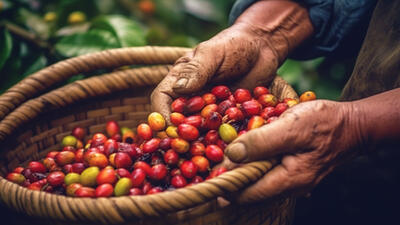
Agroecology: Ending hunger while protecting natural resources
Can vulnerabilities become opportunities for resilience and food security? We believe the answer is yes, by transforming food systems in agriculture dependent economies through agroecology.
Hunger is again on the rise, globally, after decades of progress in reducing hunger. An estimated 690 million people were food insecure in 2019, constantly worrying about the access to adequate amounts of affordable, safe, and nutritious food.
In 2022, two years into the COVID-19 pandemic, the UN Food and Agriculture Organization (FAO) estimated that number to have risen to 735 million. This alarming increase coincides with a sharp decline in agricultural biodiversity, which in turn is making food systems less resilient to climate change. Additionally, recent findings show that the internationally agreed 1.5° Celsius threshold set out in the 2015 Paris climate accords may be breached far sooner than expected.
Agriculture is not just a victim of climate change, but also a major contributor to the problem; commodity value chains are typically highly dependent on fossil-fuels, whether for fertilizers and pesticides, or the cold chain used to preserve food across thousands of miles in distribution networks.
Taken together, the world faces a precipice when it comes to global food security. The world is crying out for a food systems transformation that protects access to a sufficient, nutritious, and culturally appropriate diet while protecting the natural resource base and cutting greenhouse gas emissions. Could the crisis in fact be an opportunity to look for creative or innovative solutions?

The crisis has been in the making for a very long time. The expansion of industrial food production through the Green Revolution extracted a steep ecological price in water use and water pollution, biodiversity loss, and a heavy reliance on fossil fuel sourced inputs, including synthetic fertilizers.
The invasion of Ukraine, cutting access to both Russian and Ukrainian grain, created yet another price hike. In response, civil society groups and small-scale food producers called for an urgent, coordinated multilateral policy response with a focus on food system transformation to enable people to feed themselves in regional food systems.
Also, UN Secretary-General António Guterres established the UN Global Crisis Response Group on Food, Energy and Finance (GCRG) to respond to these unprecedented interconnected crises.
Those hardest hit by the “polycrisis” of climate, conflict and COVID are likely to live in a least developed country (LDC). Many LDCs are highly indebted, and their populations are likely to be dependent on the agricultural sector for their incomes.

Today, 46 LDCs are home to more than half of the world’s extremely poor (those living on less than $1.90 per day). One of the three criteria used for determining LDC status is the Human Assets Index, which reflects nutrition indicators, levels of health and school enrollment, per capita income, and economic and ecological vulnerability.
The complex series of indicators that define LDCs correlate dependence on agriculture (meaning a high share of agriculture, forestry and fisheries in GDP) with vulnerability.
But that vulnerability is not a given. From a resilience perspective, access to arable land, livestock and fisheries, and the knowledge of how best to cultivate them, can be a strength, not a weakness.
However, the terms on which LDCs are integrated into world markets, are deeply unequal. They reflect patterns of colonial exploitation that at times date back centuries, but also new and updated systems of exploitation, including deeply unfair rules governing public and private debt servicing and international trade.
The terms of many trade agreements compel countries to implement binding rules on saving and sharing seeds, or limit programmes to enhance biodiversity, under the threat of trade sanctions if they do not comply.
Trade should be a tool to enhance sustainable development and complement measures to enhance local resilience, rather than an instrument to compel countries to fit into global markets where commercial power is already highly concentrated.

Centering a food system transformation around small-scale producers and fishers, especially women, will go right to the heart of food systems that already produce an important share of the food feeding the world’s poorest people.
Small-scale producers are one of the four central elements of the second UN Sustainable Development Goal. Most of the world’s population lives in food systems that still rely on local production, and uncultivated foods and crops that never cross a border (nor even necessarily enter a formal market).
In the wake of the pandemic-related food crisis, smallholder producers were able to creatively respond to the food crisis in their communities. Many of the longer-value chain operations with more specialized demands ended up having to destroy their perishable produce, unable to pivot when their usual marketing channels shut down.
The lessons for the transformation we seek lie in countries’ experiences during the COVID lockdowns. To survive, countries and communities relied on a basket of strategies, varying from publicly subsidized food provision to a return to more localized food systems. The seeds of the transformation we need for food systems could be glimpsed in some of the pivots that farmers and distributors made.

In many regions local food system actors responded to changing production and marketing conditions by implementing agroecology, exploring opportunities for developing territorially embedded, equitable and resilient food systems, and building the resilience of farming communities.
Agroecology recognizes the interdependence of living systems and honors the principles of balance, diversity, harmony, and respect. The compelling stories about agroecology and food sovereignty, about initiatives that protect the food security of communities (and countries) while building resilience and adaptive capacity, are stories of hope and possibility. They flip the LDC narrative on its head, focusing on the potential these countries hold, rather than on their vulnerability.
For these countries to thrive, their governments need the policy space to invest in domestic agricultural systems and reduce their dependence on using their resources for exports, only to use the resulting foreign exchange to buy food imports for basic needs. Instead, they could be investing in food systems that protect their land’s fertility, biodiversity and their future food producing potential while supporting livelihoods and protecting access to food.
These countries can then engage in international trade as equals, not crippled by external debt and forced to over-exploit their natural resources to buy cereals for basic and caloric needs. Their economies, ecologies and people will all be the heathier for the transformation.















